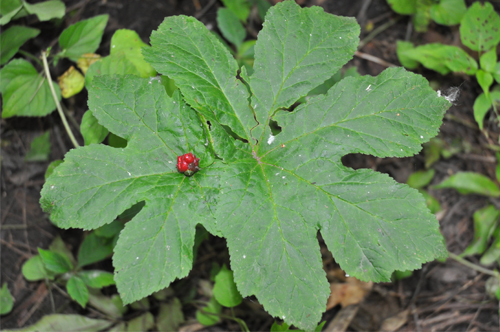Goldenseal

Photo credit: Holly Bickerton
Species information
The following is a report on progress made towards the protection and recovery of Goldenseal (Hydrastis canadensis) in Ontario from 2007 to 2021, based on Ontario’s species-specific recovery policy. This report meets the legislative requirement for a review of progress under the Endangered Species Act, 2007 (ESA or “the Act”). Goldenseal is listed as Special Concern on the Species at Risk in Ontario (SARO) List under the ESA.
Goldenseal has been classified as a species at risk since 2004. It was originally classified as a threatened species and was listed as such under the ESA when it came into force in June 2008.
The species was re-classified by the Committee on the Status of Species at Risk in Ontario (COSSARO) as a Special Concern species on January 26, 2022. This change in the status of Goldenseal (‘down-listing’) is attributed to a better understanding of the distribution and abundance of the species in Ontario, as well as to the appearance in recent decades of stability in the number of mature individuals.
Killing, harming, harassing, capturing and taking Goldenseal was prohibited between June 2008 and January 2022.
In addition, damaging and destroying the habitat of Goldenseal was prohibited between June 2013 and January 2022.
The species-specific recovery policy for Goldenseal, known as the Government Response Statement (GRS) was published in 2017 and includes the government’s recovery goal for the species and the actions and priorities it intends to lead or support to help achieve that goal. The GRS considers science advice provided in the recovery strategy, when developing recovery actions for the species. As legislated in the Act, the purpose of this Review is to report on progress made towards implementing the protection and recovery actions in the GRS. The review can also help identify opportunities to adjust and adapt the implementation of protection and recovery actions to achieve the recovery goal for the species.
Further information about Goldenseal, including the threats that it faces, and actions being taken to help protect and recover this species is available on the Government of Ontario webpage for Goldenseal. A summary on the progress towards the protection and recovery of Goldenseal and an annual update on the broader species at risk program (i.e. the Introduction to the 2022 Review of Progress report) is available on the Review of Progress towards the Protection and Recovery of Ontario’s Species at Risk webpage.
Snapshot: Progress towards the protection and recovery of Goldenseal
Progress towards meeting the recovery goal
- The recovery goal in the Government Response Statement (GRS) for Goldenseal in Ontario is to “maintain self-sustaining populations of Goldenseal throughout its current distribution in Ontario, and to support natural increases in its abundance through effective threat mitigation”.
- Progress has been made towards implementing a majority of government-led actions. Progress has been made towards implementing two of the government-supported recovery objectives and two of the associated actions. Examples of progress include:
- monitoring 10 populations of Goldenseal and their habitat
- increasing awareness of Goldenseal among private landowners
- In alignment with the GRS, further work is required to conduct research on Goldenseal demographics, ecology and habitat requirements, to monitor Goldenseal populations in Ontario that have not been subject to monitoring recently, and continue to monitor other populations, and to work collaboratively to develop, implement and evaluate the effectiveness of site management plans for Goldenseal.
Occurrences and distribution
- A total of 30 populations of Goldenseal have been documented in southern Ontario, 16 of which are considered to be extant, 12 historical, one possibly extirpated, and one extirpated.
- Since 2008, 11 newly-identified populations have been recorded, representing populations documented from locations where it was previously unknown, populations recognized as distinct and split from known populations, and records of previously-discovered populations being shared with government. These additional recorded populations are not believed to represent an increase in the number of populations in Ontario, but likely result from increased search effort and improved knowledge of the number of populations.
- New information has also resulted in some subpopulations being combined and a change to one population from extirpated to historical, while reduced monitoring has resulted in four previously extant populations now being considered historical.
Government-supported stewardship projects
- Through the Species at Risk Stewardship Program, the Government of Ontario has enabled its stewardship partners to conduct eight projects by providing $18,508 in funding that supported the protection and recovery of Goldenseal.
- The government’s support helped its stewardship partners to involve seven individuals who volunteered 70 hours of their time towards protection and recovery activities for Goldenseal. The estimated value of these voluntary contributions, as well as additional funding and in-kind support, is $44,691.
- Stewardship partners reported providing outreach on Goldenseal to 245 individuals.
Supporting human activities while ensuring appropriate support for species recovery
- Thirteen activities have been registered for the species. The activities were registered under ‘Threats to health and safety, not imminent’ (section 23.18) under Ontario Regulation 242/08 of the ESA.
Reporting on the progress towards the protection and recovery of Goldenseal
Recovery goal
The government’s goal for the recovery of Goldenseal is to maintain self-sustaining populations of Goldenseal throughout its current distribution in Ontario, and to support natural increases in its abundance through effective threat mitigation.
The implementation of government-led and government-supported actions demonstrates progress towards reaching the desired objectives and the recovery goal set out in the GRS.
Progress towards implementing government-led actions
Progress has been made towards implementing the majority of government-led actions identified in the GRS. Common actions for the government to lead as it works towards achieving a species’ recovery goal include:
- Continue to implement the Ontario Invasive Species Strategic Plan to address the invasive species (e.g., Garlic Mustard (Alliaria petiolata)) that threaten Goldenseal.
- Co-operate with federal partners, such as Environment and Climate Change Canada, to implement protection and recovery actions, where appropriate.
- Educate other agencies and authorities involved in planning and environmental assessment processes on the protection requirements under the ESA.
- Encourage the submission of Goldenseal data to the Government of Ontario’s central repository at the Natural Heritage Information Centre.
- Undertake communications and outreach to increase public awareness of species at risk in Ontario.
- Protect Goldenseal and its habitat through the ESA.
- Develop direction to provide greater clarity to proponents and partners on the areas of general habitat protected under the ESA for species at risk plants.
- Support conservation, agency, municipal and industry partners, and Indigenous communities and organizations to undertake activities to protect and recover Goldenseal.
- Encourage collaboration and establish and communicate annual priority actions for government support in order to reduce duplication of efforts.
Additionally, the government has directly undertaken the following species-specific action for Goldenseal:
- Continue to monitor populations and manage Goldenseal habitat and recreational pressures as feasible in provincially protected areas where the species occurs.
Key progress made towards implementing these actions is described in the following sections.
Ontario’s Invasive Species Strategic Plan
The GRS for Goldenseal indicates that invasive species (e.g. Garlic Mustard) may pose a threat to the survival and recovery of the species in Ontario. The Ontario Invasive Species Strategic Plan, 2012 and the Invasive Species Act, 2015 provide the policy and legislative framework to prevent new invaders from arriving and surviving in Ontario, to slow and where possible reverse the spread of existing invasive species, and to reduce the harmful impacts of existing invasive species, including impacts on species at risk. This framework may support the implementation of actions to reduce the threats from invasive species.
Guides and resources
The Government of Ontario has supported the development of the Best Management Practices in Ontario for Garlic Mustard (2012) by the Ontario Invasive Species Plant Council, to provide guidance for managing invasive Garlic Mustard and facilitate control initiatives of individuals and organizations concerned with the protection of biodiversity and natural lands.
Occurrences and distribution
A total of 30 populations of Goldenseal have been documented in Ontario. Currently, 16 are considered to be extant
Since 2008, the government’s central repository at the Natural Heritage Information Centre (NHIC) has received 95 records of the species. These records are based on observations between 2008 and 2021 and come from a variety of sources. Records submitted have helped to refine where the species is known and has been known to occur and have provided additional information on the species’ habitat and threats.
The refinements to knowledge about how Goldenseal has occupied the landscape of southern Ontario over the last 13 years are various. Three populations have been documented that were unknown before 2010. Another three populations, which were observed between 2004 and 2006, have been recognized as distinct from previously known populations. Yet another five populations, which were discovered in 1996, were reported to the government in 2009. This addition of 11 populations is not believed to represent an increase in the number of populations in Ontario; rather, it is believed to represent improved knowledge of populations. Five subpopulations that were judged to be distinct populations in 2008 are now taken to be parts of two other extant populations. Four populations that were extant in 2008 are now ranked historical due to a lack of recent monitoring. One population that was considered extirpated in 2008 is now thought to be historical while another that was considered historical is now judged to be extirpated. Overall, these data provide an improved understanding of the distribution of the species in Ontario.
It is possible that there are observations of Goldenseal that have not been submitted to the government. Encouraging the submission of observations of this species is included in the GRS as a government-led action. Submission of species observations increases our knowledge of where they occur and can play an important role in assessing the viability of species populations.
Everyone is encouraged, or may be required by an authorization or approval to submit observations of Goldenseal, and any other species at risk observed, to the NHIC for incorporation into the provincial record of observations.
-
95observations of this species were submitted to the NHIC since 2008
Government-supported stewardship projects
An important government-led action in the GRS for Goldenseal is to support partners to undertake activities to protect and recover the species. Through the Species at Risk Stewardship Program the government has supported eight projects that contributed to the protection and recovery of Goldenseal. All eight projects focused on multiple species at risk, including Goldenseal ($18,508). In addition to the government funding, partners reported that they were successful in securing additional funding from other sources, including funding for Goldenseal ($44,691). These amounts include in-kind support in the form of time and expertise provided by volunteers.
Stewardship partners reported that provincial funding helped them to secure in-kind support by involving seven individuals who volunteered about 70 hours of their time towards protection and recovery activities that focused exclusively on Goldenseal, which has an estimated value of $1,500. In addition, stewardship partners reported providing focused outreach on Goldenseal to 245 individuals.
The remainder of this section highlights a project supported through the Species at Risk Stewardship Program as well as the corresponding government-supported recovery actions for the species.
The project implemented by the Canadian Wildlife Federation during the summer of 2015 exemplifies the government-supported recovery action to monitor Goldenseal populations and habitat conditions to track trends in population abundance, demographics and reproduction (Action No. 3). This organization completed monitoring of eight Goldenseal populations in southern Ontario. Demographic information was collected including estimates of numbers of Goldenseal stems within each population and of numbers of fruiting stems. In addition, at each population location, an ecological land classification was completed. Readily observable threats were documented, which included trail widening and all-terrain vehicle traffic. In addition to being supported by the Species at Risk Stewardship Program, this monitoring received support from the Committee on the Status of Endangered Wildlife in Canada and results informed the national re-assessment of Goldenseal’s conservation status.
Species at Risk Stewardship Program
-
 8
8projects included Goldenseal
-
 $18,508
$18,508for projects that included Goldenseal
-
 $44,691
$44,691in additional funding and in-kind support
-
 7
7volunteers
-
 70
70volunteer hours
-
 245
245people received outreach
Supporting human activities while ensuring appropriate support for species recovery
Supporting partners through authorizations and their associated conditions is an important government-led action. To date, no permits or agreements have been issued for Goldenseal.
Thirteen activities that may affect Goldenseal or its habitat have been registered for the purposes of Ontario Regulation 242/08 under the ESA. Thirteen activities were registered under ‘Threats to health and safety, not imminent’ (section 23.18)under Ontario Regulation 242/08 of the ESA. These registrations require the registrant to comply with all conditions of the regulation, such as:
- giving the Ministry of the Environment, Conservation and Parks notice of the activity before it commences
- having a mitigation plan prepared by a person with expertise on Goldenseal to facilitate avoidance or minimization of adverse effects on Goldenseal while the activity is carried out
- taking reasonable steps to minimize adverse effects on Goldenseal while carrying out the activity
-
13registrations
Progress towards implementing government-supported actions
Government-supported actions are organized under overarching recovery objectives. Progress has been made towards achieving two government-supported recovery objectives and implementing two of the associated actions identified in the GRS for Goldenseal.
Objective: Improve understanding of Goldenseal habitat requirements, effects of changes to disturbance regimes, reproductive biology, and population trends to inform approaches to habitat management and species conservation.
- Action No. 3 (High Priority) - Monitor Goldenseal populations and habitat conditions using standard survey techniques to track trends in population abundance, area occupied, demographics, and reproduction at existing locations.
Under this objective, initial progress has been made towards implementing Action No.3.
This objective has been implemented through the eight projects supported by the Species at Risk Stewardship Program which focused on 10 of the 16 populations that are considered extant.
Objective: Increase public awareness about Goldenseal, its potential threats and approaches to address threats.
- Action No. 7- Increase awareness among private landowners and the public about Goldenseal, its protections under the ESA, and its vulnerability to illegal harvest. Educate users of herbal medicines on the status of the species and legal sources of Goldenseal to support demand reduction for wild populations.
Under this objective, initial progress has been made towards implementing part of Action No. 7.
This objective has been implemented through three projects supported by the Species at Risk Stewardship Program, which included outreach to private landowners.
Summary of progress towards meeting the recovery goal
The recovery goal for Goldenseal is “to maintain self-sustaining populations of Goldenseal throughout its current distribution in Ontario, and to support natural increases in its abundance through effective threat mitigation”. Effort made towards the government-led and government-supported actions have helped to make progress towards this goal. For example, the Government of Ontario’s efforts to raise awareness of Goldenseal and control the spread of invasive non-native plants, along with the protection afforded to Goldenseal and its habitat under the ESA between 2008 and 2022, supported the maintenance of self-sustaining populations during this period. As well, the prohibitions against killing or harming Goldenseal that were in effect during this time may have been a factor that inhibited poaching and thereby contributed to the status change from Threatened to Special Concern in January 2022. Monitoring of Goldenseal populations and collection of demographic information have improved our knowledge of this species in Ontario and supported assessments relating to whether self-sustaining populations are being maintained, contributing to its status change.
Recommendations
As stated in the GRS, this review of progress can be used to help identify whether adjustments to the implementation of GRS actions are needed, to achieve the protection and recovery of the species. Based on progress to date, the overall direction provided in the GRS for Goldenseal, particularly the implementation of actions identified as high priority, should continue to guide protection and recovery of the species.
Although initial progress has been made towards the action to monitor Goldenseal populations and habitat conditions (Action No. 3) and the action to increase awareness about Goldenseal among members of the public (Action No. 7), further work is required to fully implement these and other actions. For example, monitoring of 10 populations has taken place between 2008 and 2018, but 16 populations have not been monitored during this period.
In addition to Action No. 3 and No. 7, the following actions require support to further the management of the species:
- Action No. 1 (High Priority) - Collaboratively work with landowners, land managers, municipalities and the community of Bkejwanong (Walpole Island First Nation) and other interested Indigenous communities and organizations to minimize threats to the species and maintain or enhance habitat conditions for Goldenseal by:
- developing, implementing, and evaluating the effectiveness of site management plans for Goldenseal, including for logged woodlots
- removing invasive species (e.g., Garlic Mustard) in Goldenseal habitat, in locations where invasive species are degrading habitat or threatening the species
- implementing best practices for woodlot management to support suitable habitat conditions for Goldenseal
- minimizing site-level threats to the species by redirecting recreational activities through the use of signage and fencing, as appropriate
- monitoring the species’ and habitat responses to invasive species control, woodlot management and canopy thinning, and threat management to inform adaptive management of the habitat
- Action No. 2 (High Priority) - Conduct research on Goldenseal demographics, ecology and habitat requirements, including:
- research into the effects of forest fragmentation and alterations to disturbance and hydrologic regimes (e.g., land drainage, flood mitigation) on Goldenseal
- research on Goldenseal seed pollination, dispersal and germination, and seedling ecology
- Action No. 4 - Survey historical locations of Goldenseal to determine if populations are extant.
- Action No. 5 - Investigate knowledge gaps related to the resilience of Goldenseal populations to harvest and the prevalence of this threat in Ontario.
- Action No. 6 - Work with Indigenous communities and organizations to record, share and transfer Traditional Ecological Knowledge on Goldenseal as available, including information on the condition of the species and its habitat to inform habitat management actions.
As stated in the GRS, this review of progress can be used to help identify whether adjustments are needed to achieve the protection and recovery of the species. Based on progress to-date, the overall direction provided in the GRS for Goldenseal should continue to guide protection and recovery of the species.
Protecting and recovering Goldenseal will continue to be a shared responsibility that will require the involvement of many individuals, organizations and communities. Financial support for the implementation of actions may be available through the Species at Risk Stewardship Program. By working together, progress can continue to be made towards protecting and recovering Goldenseal in Ontario.
Footnotes
- footnote[1] Back to paragraph A population is considered extant if it has been observed within the last 20 years. Extant populations may have been extirpated, particularly if observations are not recent and updated information is unavailable.
- footnote[2] Back to paragraph A population is considered historical if it has not been observed within the last 20 years. Historical populations may still exist, but updated information is unavailable.